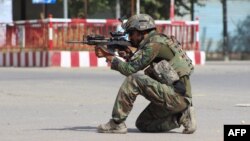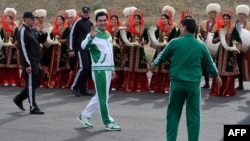
The northern Afghan city of Kunduz is under assault again, a year after it was briefly captured by the Taliban. Tens of thousands of civilians have been forced to flee as the Afghan military and Taliban militants fight it out on the streets.
In late September 2015, when the Afghan military retook the city, the Taliban did not flee very far away, making the current battle to a large extent predictable.
What happened in the year between the Taliban attacks on Kunduz? Did the Afghan government take any measures to prevent a repeat of the September 2015 fiasco? And how is it that the Taliban could attack the same city?
RFE/RL gathered a majlis, a panel, to look into those questions.
Moderating the discussion was RFE/RL Media Relations Manager Muhammad Tahir. From Afghanistan, Kamal Safi, a parliamentarian representing Kunduz Province, joined the talk. Also from Afghanistan, the former governor of Kunduz Province, Omar Safi (no relation), took part. From Washington D.C., Barmak Pazhwak, the senior Afghanistan program officer at the U.S. Institute of Peace, participated. And as usual, I was in Prague and had a bit to say also.
The Taliban's brief capture of Kunduz city in September 2015 was a shock to most. The Taliban had been active in the northeastern provinces of Badakhshan, Kunduz, and Takhar but had never seized a provincial capital since it had been driven from power in Afghanistan by the U.S.-led invasion 14 years previously.
The militants were driven out of Kunduz in just a few days, but villagers near Kunduz, and members of the government in Kabul, said many times that the Taliban had only retreated to areas outside the city -- in some cases only a few kilometers away.
Kamal Safi described the current situation, as of October 5. "Apart from a few buildings like the governor's house, the police chief's office, and [a few others], the rest of the city is still [under] the Taliban and they are resisting the offensive of the security forces," he said.
The parliamentarian said civilians were faced with "no electricity, no water. There is no food, all the food shops are closed ... and if any bread is available in some parts of the city, the cost is four or five times higher [than usual]."
Former Kunduz Governor Omar Safi said the problem now was the same as last year. "There is no coordination and there is no interest from the government security forces' side to fight against the enemy." He pointed out that when this latest battle started there were "only one or two dead of the government forces," a sign, Safi said, that government troops had retreated almost as soon as the attack started. (Editors' note: Government forces have since launched a counter-offensive.)
Corruption Hampering Government Efforts
The former governor said that when the Taliban staged the September 2015 attack on Kunduz "we had only one regiment in Kunduz." The Afghan government did reinforce troops in Kunduz. "There are three battalions," Safi said, "So there are around almost 18,000 troops in Kunduz Province."
Pazhwak said: "The Afghan government hasn't been able to establish a control and command structure for this war in Kunduz that is unified and well-coordinated among the different security forces of the country."
But as has happened in so many other places in Afghanistan, corruption is playing a large part in the failures of government forces. [Omar] Safi said, "President [Ashraf] Ghani approved 550 million Afghani to Kunduz city, just to make a security belt for Kunduz." But unfortunately, "this money was all lost, misused" and he added none of the planned 17 security bases that were to have surrounded Kunduz city were ever built.
There are other reasons why government forces were struggling to pacify Kunduz Province. Pazhwak noted: "Kunduz, unfortunately, is practically a divided province. It is divided among a few power brokers, warlords, and a patronage system that could be traced all the way to Kabul."
Parliamentarian Safi added: "Kunduz is known as a small Afghanistan in the sense that all tribes who live in Afghanistan live in Kunduz as well, from all the small tribes [and] big tribes."
'Russian Buffer Zone'
But former Kunduz Governor Safi offered another interesting reason the Taliban were so difficult to suppress in Kunduz Province. "Most important is their [Taliban] recent ties with the Russians to keep this as a buffer zone for Russia to prevent [Islamic State] infiltration to a former Russian state like Tajikistan."
Tajikistan's Asia-Plus independent news agency reported on December 29, 2015, that Russian Ambassador to Afghanistan Zamir Kabulov confirmed that Taliban representatives from northern Afghanistan met with Russian officials at an air base Russia's military used in Tajikistan. The Asia-Plus report named one of the Taliban officials as being "Qori Dinmuhammad Hanif, a commander of the Taliban from northern Afghanistan," and the report said Russian officials had met not once, but several times with Taliban officials at the base in Tajikistan, seemingly without the Tajik government's knowledge.
The report continued that government forces were unable to dislodge Hanif's forces from a district in Badakhshan Province, east of Kunduz Province, because "it [the district] is guarded with Russian weapons."
Former Governor Safi said local militiamen, called Arbaky, often simply paramilitary groups loyal to local warlords, had "seen some huge ammunition ships coming from the Tajik side to the Taliban side to distribute."
Outside of Ambassador Kabulov's comments, Russian officials have not spoken publicly about meetings or contacts with Taliban representatives.
Parliamentarian Safi would say only that "Kunduz has a long border with Central Asia and ... regional interests have changed." He added: "We also cannot deny that some of the local commanders, apart from the Taliban, have [made] frequent visits [to] the Central Asian states."
Our guests discussed these topics in greater detail, especially providing information about the complicated situation in Kunduz that seems to indicate there is no possibility for any resolution, anytime soon.
An audio recording of the Majlis can be heard here:
Listen to or download the Majlis podcast above or subscribe to Majlis on iTunes.








